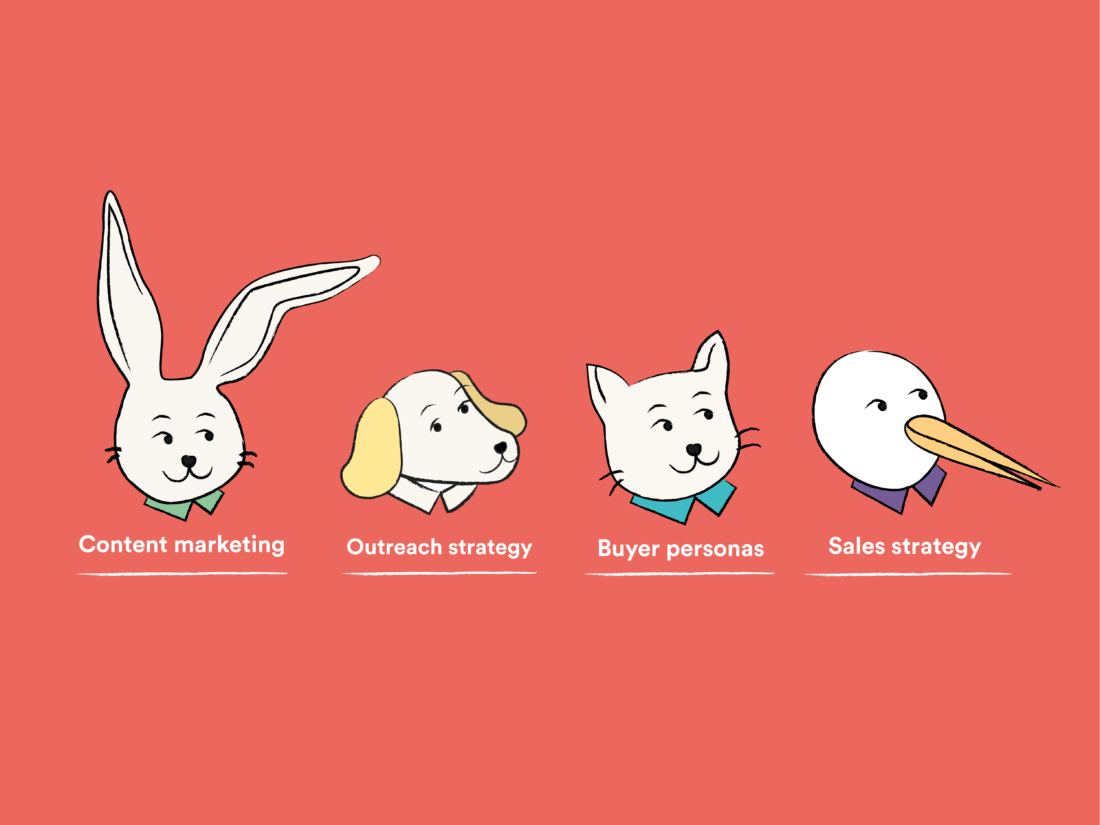90% of startups fail. Does that put you off? Or does it motivate you to succeed? Let’s hope it’s the latter. With a solid go-to-market strategy, you could be part of the 10% of successful startups reaping the rewards of their confidence and hard work.
But how do you create the ultimate go-to-market strategy? And, more importantly, what does it mean, and why do you need it? These are all good questions, and luckily for you, we’re going to be answering each one in detail.
By the end of this article, you’ll be able to launch your product to the masses and watch as your new brand builds traction amongst your target audience. Sounds like a dream, right? Let’s get into it.
What is an early-stage startup?
You know what a startup is, but do you know the different stages? The early stage, or seed stage, is where product details, functionality, pricing strategy, and target market are finalized. Most startups in this phase have a tested prototype after identifying a product-market fit and are now focusing on how to launch the final product.
This is a key stage to getting organized and ensuring success. The company will primarily be focused on collecting market research, planning its product launch, ensuring its product or service is high-quality, and figuring out its value proposition.
This is an exciting time for startups but also a crucial time for getting it right. Without a solid go-to-market strategy, it can be hard to organize the whole team. But what does that look like?

What is a go-to-market strategy?
A go-to-market or GTM strategy is the crux of how your company is going to present your product to potential customers. This includes:
- Content marketing
- Creating buyer personas for particular demographics
- Sales strategy
- Outreach strategy
It will focus on addressing your target audience’s pain points and offering a solution in a presentable and effective way. Marketing efforts at this stage are normally more focused on lead generation and brand awareness than conversions, but obviously, they do go hand in hand.
This kind of strategy differs from a sales or marketing plan, as it encompasses every element of your business. It will decide future strategies and focus each department of the company on one long-term goal.
Every company will need its own specific go-to-market plan. However, there are certain elements and best practices that will benefit all early-stage startups. We’ll get into that later.

Why does an early-stage startup need a market strategy?
It is absolutely essential an early-stage startup has this kind of strategy in place. Without one, you will struggle to reach your audience or create any sort of conversation around your new brand. It will also:
- Give your company a competitive advantage if your industry is already saturated
- Give you clear KPIs and metrics to focus on and measure the success of your launch
- Create a strong customer base
- Focus your whole team on a common goal
These reasons will increase your referrals and profitability. Which, for startups, is essential. Those first few months of investment with no return are always a struggle. Having a clear GTM strategy should reduce the amount of time you go with no income.
Launching your product or service without a strategy in place is a no-go. You’ll waste time, money, and effort.

How to build your go-to-market strategy
Your strategy will differ from other companies, and that’s a good thing. It all depends on your business model. However, there are a few key steps to take when building the right one for your company.
Visualize your ideal customer
In order to know how to brand your product, you need to know who it’s for. You’re creating a brand new customer base, and that takes a lot of research and planning. Ask yourself the following questions:
- What age are my customers?
- What gender are they?
- What kind of income do they receive?
- What industry do they work in?
- How do they spend their spare time?
- Why do they need your product?
By answering these, you’ll start to build an idea about how to target customers. Alongside this, be sure to thoroughly research the ideal demographic. Take into consideration:
- What social media they use (if any)
- Pain points in their life
- Education level
- Marital status
- What they read/watch
Compile all the data you have found into a customer persona template. This will be a good way to visualize the information and share it with the whole team. This means at every step of the way, you can envision this customer and make decisions based on those traits.

Draw out your sales cycle
This customer persona will not only be helpful for your marketing team but also for your sales team. Your sales cycle should be personalized to your customers. A generic approach just won’t cut it. A rough plan should follow the steps below:
- Prospecting: From your customer persona, identify businesses and people that would benefit from your product. Start building relationships with those prospective clients.
- Connect: Directly reach out to them and identify problems they have and the solutions your product can offer.
- Research: Get to know everything about your prospective clients. What they need, what they’re missing, and how your service fits into their world.
- Present: Find the decision makers and present the value proposition of your company.
- Handle objectives: Recognise and validate any concerns they have, but then explain why they shouldn’t be concerned by offering genuine solutions or explanations.
- Close: Find a mutually beneficial agreement and decisively close the deal.
- Follow up and get referrals: Keep contact consistent and supportive to build a long-lasting relationship.
Now, depending on your industry and your audience, each one of these stages will differ slightly based on their preferences. For example, if you’re a content writing service, your follow-up is equally as important as closing the deal. However, if you’re just selling a product, then a follow-up might not even be necessary.
The more personal your sales cycle, the more likely customers are to trust you. This is particularly important for early-stage startups. How your salespeople conduct themselves will determine how your brand is perceived and, ultimately, how successful you’ll be.
Decide on your digital marketing strategy
Okay, you’ve got your ideal customer burned into your mind and your sales cycle nailed. But how will you actually reach your audience? How will you increase brand awareness? This is where your marketing team needs to step up and organize a watertight digital marketing strategy.
When building this strategy, you need to consider everything:
- Social media: A huge part of digital marketing now takes place on social media. You need to decide which platforms to focus on, your tone of voice in your posts, how often you are posting, and what you are posting. A good social media strategy can be the difference between a brand becoming a household name and a startup failing in the first few months. Contact influencers, build a profile on LinkedIn, and post regularly. If you build an audience to gain traction before your product release, you’ll have a good customer base to kickstart your launch.
- Website content: Blogging is all the rage. And it’s not surprising. It gets results. For people to find your business, you need organic traffic. This means your content is showing up on search engine results pages (SERPs) so people click through to your site. In order for this to happen, your content needs to take into account search engine optimization (SEO). This includes targeting relevant keywords, including visual additions to text, and adding alt text to images.
- Email marketing: Email outreach is essential in generating leads and keeping loyal customers. Newsletters, promotions, and updates are all examples of email campaigns that can generate great results. Getting people to subscribe to your startup’s email list will improve brand awareness and loyalty. Customers will be invested in your success and progress if they get regular updates, so when you eventually launch your product, you should already have some interested prospective clients.
- Pay-per-click advertising: Building a following from scratch just using organic traffic takes a lot of time, investment, and patience. PPC (pay-per-click) advertising is a great way to speed up the process and get your brand noticed. The beauty is that you only pay for how successful you are, so you know money won’t be wasted. Decide which keywords to target and organize them well.
Without a digital marketing strategy, your startup will not be successful. When you go to market, your strategy should be scheduled, organized, and ready to go. Even better, it can be automated so it can keep ticking over in the background whilst you work on producing the next month’s content.
Content creation takes a lot of work, but it’s necessary. Otherwise, what are you going to bring to the market? Consider investing in an agency that can take care of your web content and possibly a full-time content creator for your social channels.

Organize your launch day
Now you’ve got everything in place to nail your product launch. But how are you actually going to execute it? Luckily, there are plenty of options to choose from. Whether you want to focus primarily on a social media campaign or maybe you want to use a website like Product Hunt—it depends on your audience and industry.
Whichever you choose, there are some important steps to take to make sure the big day goes smoothly:
- Set your goals: Having clear and ambitious but achievable goals will keep your team focused and motivated. Consider what metrics and KPIs you’d like to measure, like click-through rate, engagement, brand awareness, organic traffic, conversions, and more. What do you want to achieve from the launch? What position do you want to be in after the launch? If you know the answers, that’s a good sign. If not, call a team meeting and come to an agreement on what to prioritize and what’s important for the company.
- Prep your team: Every department needs to know the plan for the day to run smoothly. From your sales team to your marketing team, they all need to be on the same page. This will help in content creation, optimizing sales, and engaging with your audience. Remember, you’re in this together.
- Schedule in advance: Consider the time zone, location, and the best day to launch. This will depend on your product and the type of customers it’s targeted for. For example, if you’re a SaaS company, then midweek during office hours will be most effective. But if you’re a more personal product, like in the beauty industry, then maybe weekends would be a better fit. Once you decide, schedule posts and updates in advance, so everything is published smoothly and on time.
- Enjoy it and engage: Keep on top of conversations around your brand. Interacting with followers will add a personal touch that will boost loyalty and trust. We’re humans, at the end of the day, looking for human connections! The more you nurture leads, the more likely you are to close them and turn them into conversions.
You may want to sit back and relax after the launch, but don’t be fooled. The real hard work is yet to come. This time should be spent measuring your success and assessing whether you met your goals. If you didn’t, what went wrong? Do you need to go back to the drawing board? Was it the product or the strategy?

Top tips on executing your go-to-market strategy
So, we’ve got the core of how to build a successful go-to-market strategy. But how do you ensure it will work? We’ve put together our top tips to make sure your early-stage startup has the best possible chance of succeeding.
- Be consistent: Consistency is key. If you blog every week but then suddenly drop off the face of the earth for a year, you can’t expect your organic traffic to stay put. It’s going to plummet, and it will be hard to come back from. For a new brand, people need to see consistent updates to remain invested.
- Be patient: No one wakes up to a fully formed brand overnight. When you go to market, you need to be patient. If you have set unrealistic goals, you might find yourself becoming too pushy or salesy. Customers smell desperation. Don’t force something that isn’t quite right yet. Keep working at it, and soon you’ll see the rewards.
- Use a project management platform: There is so much software out there to make your life easier. You’d be a fool not to use it. Project management platforms are designed to make workflows simple and smooth. You can have a space dedicated to organizing all of your different efforts and keeping track of them all.
- Decide on your key message: It’s easy for your brand’s message to be lost and become convoluted along the way. By deciding on a key message based on your company values and ensuring every decision and every piece of content created and shared is aligned with that central message, your brand will come across clear and consistent. This will help build brand awareness because you’ll be recognizable for that message.
- Research, research, research: You cannot underestimate the importance of research. If your strategy is not backed by up-to-date data, it will soon become clear. In order to have a convincing brand, you need to know everything about your product, your audience, the lifestyle, and the industry.

Ready to level up your startup?
Being part of a startup is an incredible experience. Watching an idea blossom and grow into a fully formed business is satisfying and rewarding. But it also takes some nerve, knowing the statistics on failure, to commit and invest. When you do, it’s because you know your idea has value.
Don’t waste the potential with a mediocre GTM strategy. It could be the most important plan of your life. So, be sure to take your time, organize your efforts, and go all in. If you follow our plan, success awaits.
Have you recently launched a new product to the market? How did it go? Let us know what strategy you used and the results in the comments so our readers can learn from past experiences.









